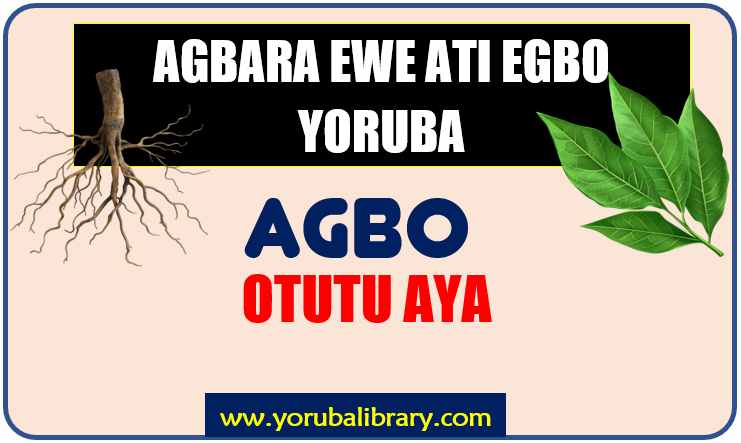
support@yorubalibrary.com
+2348073529208, 07038599574

Chest cold (Òtútù àyà) is a common ailment that often begins with mild cough or catarrh and later develops into heavy breathing and chest pain if ignored. In Yoruba traditional medicine, the chest is seen as the seat of life, where the lungs (ẹdọfóró) and heart (ọkàn) work together to maintain strength and vitality. When cold air, dust, or moisture enters the body excessively, it weakens the chest region, leading to difficulty in breathing, mucus buildup, and general body fatigue. Our forefathers believed that coldness in the chest happens when the natural internal warmth is suppressed. Once this balance is lost, the lungs become congested, and the body struggles to function normally. Agbo Òtútù Àyà was therefore formulated using warming and decongesting herbs that help drive out cold, dissolve phlegm, and restore free breathing.
Our forefathers believed that coldness in the chest happens when the natural internal warmth is suppressed. Once this balance is lost, the lungs become congested, and the body struggles to function normally. Agbo Òtútù Àyà was therefore formulated using warming and decongesting herbs that help drive out cold, dissolve phlegm, and restore free breathing.
This Yoruba herbal preparation is highly famous for its ability to bring quick relief to people suffering from persistent cough, catarrh, and chest pain. It is still widely used today, especially during cold or rainy seasons, to keep the chest clear and breathing smooth without relying on synthetic drugs.
Disclaimer
Yoruba Library and its Team will not be held liable for improper usage or any loss arising from improper use, wrong application, inability to find needed materials, or misinterpretation of this article. This article is provided strictly for guidance and educational purposes.
Symptoms Treated
Agbo Òtútù Àyà is used in traditional medicine to treat symptoms such as:
• Tightness or heaviness in the chest
• Persistent coughing with mucus or phlegm
• Difficulty in breathing or shortness of breath
• Wheezing or noisy breathing during rest
• Catarrh and nasal blockage
• Pain or pressure around the ribs and upper back
• Cold sensation in the chest region
• Fever or body weakness caused by chest infection
• Occasional choking feeling during sleep
• General tiredness or dizziness from poor airflow
How Our Forefathers Treated Chest Cold in the Past
Use of special root and herbs:
They combined leaves with properties that will repeal Otutu Aya. These herbs help open up the chest and dissolve thick mucus naturally. Find below some of the leaf needed to prepare medicine for Otutu Aya:
1) Ewe Ope
2) Ewe Emi
3) Ewe Elu
4) Ewe Ahùn
5) Ewe Arere
6) Ewe Àfe
7) Ewe Botuje
8) Ewe Dagunro
9) Epo Kaju (Cashew tree bark)
10) Ewe Zoro Igbo
Have you heard of Yoruba Herb Dictionary? This contains names of Yoruba Leaf, Roots, Barks, Characteristics, Properties & Identification with HD Pictures. Order below or download sample here
A-Z HERBS & LEAF DICTIONARY #4KOne Yoruba proverb says "Bí olóde ò kú, òde rè kì í wu Gbégi". Do you know that Gbégi is actually a leaf/plant? Get Yoruba Proverbs on Plants and Herbs, which is a collection of Untold Wisdoms Hidden in Leaf and plants comprising their Life Applications & Moral Teachings. Order below or download sample here
YORUBA PROVERBS ON PLANTS #4KThe Healing Process in Traditional Practice
1. Cleansing the Airways – The herbs work gradually to clear mucus from the lungs and free the breathing passage.
2. Restoration of Inner Warmth – Spices like ataare and orógbó generate internal heat, balancing the body’s temperature and driving out cold.
3. Strengthening of the Chest Muscles – Constant use of the decoction tones the chest region and prevents future cold accumulation.
Differences Between Yoruba and Modern Treatment
• Natural vs Synthetic:
Yoruba medicine focuses on natural roots, leaves, and barks, while modern medicine relies on laboratory-produced drugs.
• Body Balance Approach:
Yoruba healing restores lost internal warmth, not just symptom relief. Modern treatment may suppress cough but might not remove the root cause.
• No Chemical Side Effects:
Traditional herbs used in Agbo Òtútù Àyà are safe when prepared properly, while synthetic drugs may cause drowsiness or stomach upset otherwise known as side effects.
Safety First: Important Contraindications and Considerations
1) Pregnancy and Lactation: Some potent herbs are unsafe for pregnant or breastfeeding women. Forefathers insisted these must never be used during this period.
2) Underlying Conditions: Individuals with chronic health issues like kidney or liver disease should seek herbalist guidance before using strong decoctions.
3) Source Quality: Plants grown with chemicals, pesticides, or harvested from polluted areas can harm instead of heal. The source must always be trusted.
Needed Materials (Leaves, Roots, Bark, etc.)
The medicinal approach for this requires careful selection of natural materials traditionally known to our elders. These are combined to ensure potency.
The instruction you will receive is the original account of our forefathers, preserved and tested over time. Many people have used them with testimonies of relief. Just ensure you follow the correct guidelines. Click Unlock Secret below
Application Process
The strength of Yoruba medicine depends on how materials are handled. Proper pounding, boiling, or steeping — done in the right way and at the right time — ensures the remedy remains potent. Click Unlock Secret below
Uses
The prepared remedy must be applied in the correct manner — whether for drinking, steaming, bathing, or chest rubbing — and taken in the right dosage for it to remain effective.
1) Some leaf required special utterances/chants before they can be effective. Where applicable, this will be stated in the PDF
2) The methods of getting the needed items like leaf, bark, roots by yourself is covered in the PDF
3) Saa bi Ologun ti wi, ki o le baa je... (Follow instructions for it to remain potent). You're getting a Real and Original account of our fore fathers.
With Numerous Satisfied Clients...